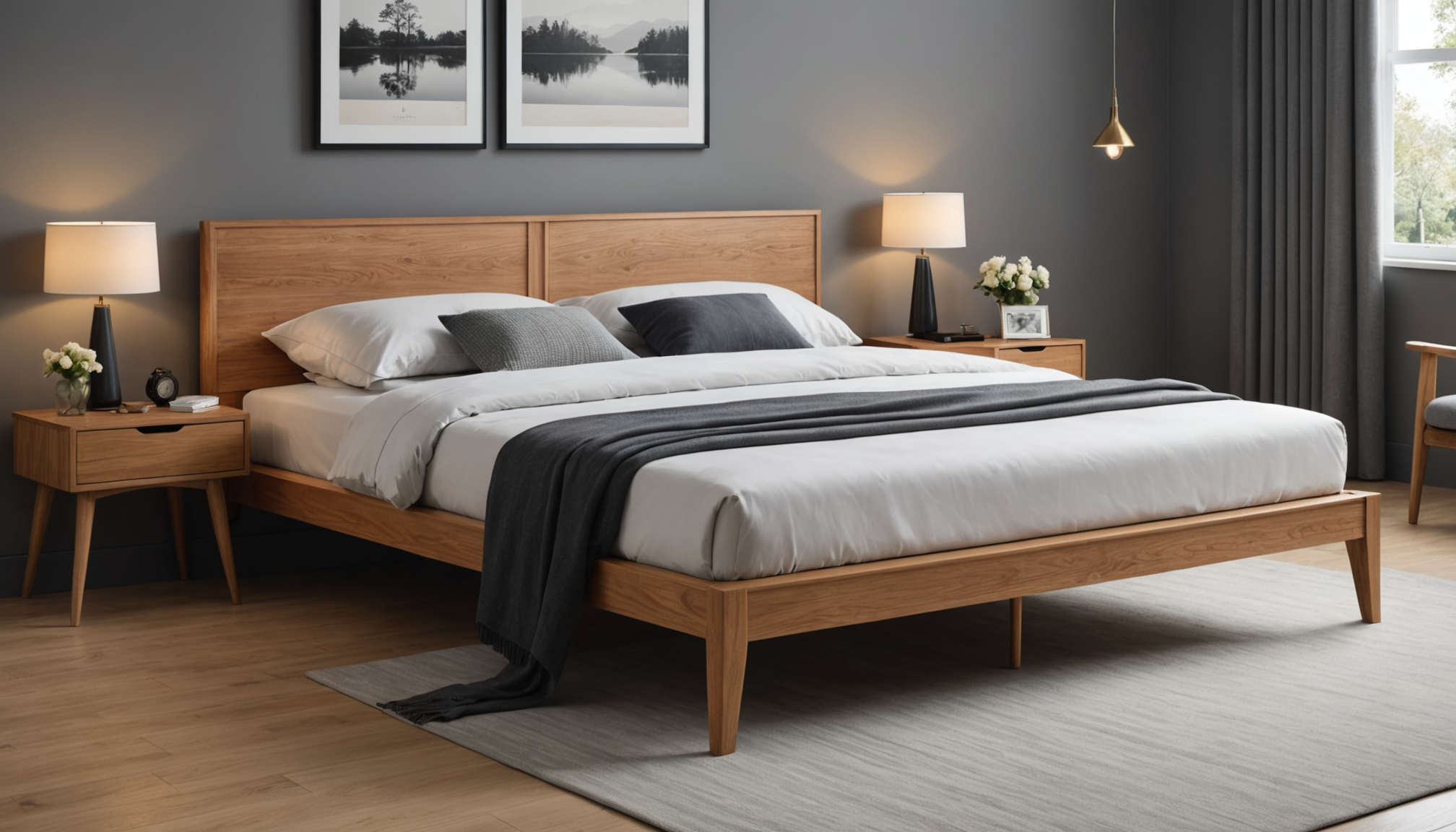Embarking on the journey to create a well-curated bedroom space requires a deep understanding of the essentials that form the core of this intimate sanctuary. A well-designed bedroom not only caters to your personal comfort and aesthetic preferences but also holds the potential to enhance the overall resale value of your home. By focusing on the foundational elements of your bedroom, you can ensure it becomes a place of rest and rejuvenation for you and your family.
At the heart of any bedroom’s functionality and ambiance lie a few critical components. These essentials include the mattress, bed frame, furniture, and decor. When harmoniously integrated, these elements create an inviting atmosphere that can cater to both individual style and broader functionality.
Acknowledging the significance of these basics, it’s important to first consider the function your bedroom serves. While it is primarily a place for rest, it may also need to be a multipurpose space that accommodates work or family activities. This multifaceted use necessitates careful selection and arrangement of your bedroom essentials.
| Aspect | Considerations |
| Mattress | A good mattress should provide adequate support and comfort, potentially improving health and sleep quality. |
| Bed Frame | The right bed frame can stabilize your bed and complement your bedroom’s aesthetic. |
| Furniture | Functional furniture, like dressers and nightstands, should provide utility without sacrificing space. |
| Decor | Decor elements should reflect your personality and contribute to a calming ambiance. |
The climate maintained in the bedroom is equally influenced by the HVAC system, which plays a crucial role in ensuring a comfortable sleeping environment. As homeowners look for ways to enhance comfort, upgrading or regularly maintaining the HVAC system becomes an essential consideration, not only for immediate comfort but also for long-term health benefits.
Additionally, as you analyze these core components, remember that each choice can contribute to your bedroom’s thermal efficiency. Selecting energy-efficient options can also subtly influence the overall energy consumption of your home, which, in turn, can add to its resale value. Whether it’s choosing a mattress with advanced cooling features or furniture that maximizes space and resources, each decision should be strategically aligned with both immediate comfort needs and long-term property investment goals.
selecting the perfect mattress
One of the most crucial decisions in curating a comforting and rejuvenating bedroom environment is selecting the perfect mattress. This choice not only affects your nightly rest but also impacts your overall health, well-being, and even the resale value of your home. Here’s a step-by-step guide to help you choose a mattress that best fits your needs and lifestyle:
- Assess Your Sleep Preferences: Start by evaluating how you sleep. Do you sleep on your back, side, or stomach? Each position requires different levels of support. For instance, side sleepers might prefer a softer mattress that contours to their body shape, while back or stomach sleepers may need a firmer surface to support spinal alignment.
- Understand Mattress Types: Familiarize yourself with different mattress types. Common types include innerspring, memory foam, latex, and hybrid models.
- Innerspring: These provide a traditional feel with bouncy support and are generally cooler options due to better airflow.
- Memory Foam: Known for excellent contour and pressure relief, these mattresses can be good for side sleepers who need support for their hips and shoulders.
- Latex: Offering a bouncy and responsive feel, latex mattresses are durable and often more eco-friendly.
- Hybrid: These combine coils and foam for a balanced feel of support and comfort, catering to a broad range of sleepers.
- Consider Health Needs: If you have any health issues such as back pain or allergies, they should strongly influence your choice. For example, certain orthopedic mattresses are specifically designed to alleviate back pain, while hypoallergenic materials can benefit those with allergies.
- Evaluate Material Quality: A high-quality mattress should be durable and supportive. Look for reputable brands that provide warranties and ensure that materials used are certified for safety and performance standards, which can affect long-term comfort and sustainability.
- Test for Comfort and Support: Whenever possible, physically test the mattress in a store. Spend at least 10-15 minutes lying on each one in your preferred sleeping position to gauge comfort levels. For online purchases, check the return policy and trial period options to ensure you can make an exchange if needed.
- Factor in Temperature Regulation: Your bedroom’s climate is influenced by your mattress’s ability to regulate temperature. Products with cooling gel layers or breathable structures are advantageous in warmer environments or for those who tend to overheat during sleep.
- Set a Budget: While a mattress can be a significant investment, setting a budget is important. Consider the mattress’s expected lifespan against its price to determine value over time. Remember that an excellently suited mattress can improve sleep quality leading to enhanced daily productivity and health, aiding in maintaining or increasing your home’s resale value.
- Seek Family Feedback: If sharing a bed with a partner, ensure that the mattress suits both parties’ needs or consider a split option where each side offers different firmness levels. Family consensus can pave the way for a more harmonious sleeping environment.
Incorporating these steps into your decision-making process ensures your selection aligns with both immediate comfort requirements and long-term health benefits. A carefully chosen mattress can serve as a critical cornerstone in creating an inviting and functional bedroom haven, contributing to a higher quality of life and the intrinsic value of your home.
choosing the right bed frame
When it comes to selecting the bed frame that complements your mattress and bedroom decor, the options can seem endless, each with unique characteristics that can transform your sleeping environment. The right bed frame not only secures your mattress but also enhances the bedroom’s aesthetic and overall function.
Start by considering the material of the bed frame, as it plays a major role in the design and durability of your bed. Wooden frames are a classic choice, providing a warm and timeless appearance. They vary widely, from sleek, minimalist designs to elaborate carvings, offering versatility to match nearly any decor style. Metal frames, on the other hand, often cater to more modern or industrial tastes, offering sturdy and cost-effective options. Their minimalist design can make a small bedroom feel more spacious, which is essential if space optimization is a concern.
The style and design of the bed frame must align with your bedroom theme. For instance, a platform bed can appeal to those who favor low-profile, contemporary aesthetics, offering a sleek look that often eliminates the need for a box spring, thereby reducing costs and simplifying the setup. Conversely, a canopy bed can introduce a dramatic flair, ideal for more traditional or luxurious decor styles where height is an advantage.
Next, assess the functionality of the bed frame. Storage is a critical factor for many families, especially if the bedroom does double duty as a storage space. Opting for a frame with built-in drawers or under-bed storage solutions can be invaluable in maintaining an organized and clutter-free room, thus increasing the room’s utility without compromising on style. This functionality is particularly beneficial in apartments or smaller homes where maximizing every square foot is essential.
Frame Dimensions are equally important. You need to ensure the chosen bed frame accommodates your mattress snugly and fits comfortably within your bedroom. Consider the dimensions of the room to avoid overcrowding the space, especially if you plan to incorporate additional furniture like nightstands or dressers. Your bed frame should contribute to a feeling of openness, allowing for easy movement around the room and complementing your bedroom’s overall layout.
If you’re concerned about creating a sustainable bedroom, consider a frame made from eco-friendly materials. Look for certifications that demonstrate a commitment to sustainability and manufacturing processes that lower carbon footprints. Such choices may subtly enhance your home’s resale value by appealing to future buyers who prioritize environmental responsibility.
Lastly, consider the ease of assembly and maintenance. Some frames require more complicated assembly, which might be a concern if you prefer a hassle-free setup or plan to move frequently. Also, ensure that your chosen frame is easy to maintain and durable, providing long-term satisfaction without sacrificing its visual appeal.
By choosing a bed frame carefully and ensuring it matches both your personal style and practical needs, you can create a harmonious and aesthetically pleasing bedroom environment. This decision can significantly enhance your bedroom’s functionality and, much like your carefully chosen mattress, contribute to the overall value and appeal of your home.
incorporating functional furniture
Updating your bedroom’s functionality is key to creating a space that is both inviting and practical, and incorporating the right furniture plays a significant role in achieving this. The strategic selection of functional furniture can transform your bedroom into a haven of comfort while also offering practical solutions that fit your lifestyle.
Begin by addressing your storage needs, an essential element for maintaining a tidy and organized environment. Investing in multi-functional pieces such as dressers with deep drawers or nightstands with built-in shelving can provide ample space to tuck away clothing, books, or bedtime essentials. Consider a bed frame with storage capabilities, such as those with under-bed drawers or lift-up mattresses that create a hidden storage area. This not only maximizes your bedroom’s utility but can also contribute positively to your home’s resale value by showcasing efficient space use.
Another critical consideration is the incorporation of seating options. A cozy armchair or a small reading nook can introduce an element of relaxation, making your bedroom a versatile area for unwinding beyond merely sleeping. If space permits, adding a bench at the foot of the bed or a window seat can offer a convenient spot for putting on shoes or an extra storage opportunity for seasonal items. These touches add layers of functionality and style, further personalizing your space.
For a shared bedroom, such as a master suite or a room designed for family use, opt for adaptable furniture solutions. Modular furniture pieces, which can be rearranged or added to as needs evolve, are perfect for family use. A fold-out desk or a convertible vanity can serve dual roles, catering to both work-from-home situations and personal grooming needs, merging functionality without sacrificing aesthetics.
To enhance the cohesion and flow of your bedroom, selecting furniture that complements the room’s overall decor and desired ambiance is crucial. Harmonize the finishes and materials of furniture pieces so that each item integrates seamlessly into the space, creating a unified look that enhances the room’s aesthetic appeal. This consistent styling encourages a more restful and visually pleasing environment.
Don’t overlook the importance of furniture that promotes health and well-being. Ergonomically designed pieces can minimize strain and contribute to comfort. For instance, chairs with good lumbar support will benefit any desk setup, while adjustable bedside lighting can reduce eye strain during nighttime reading.
Furniture that supports your HVAC system’s efficiency is also an advantageous choice. Strategically placed pieces that allow for unobstructed airflow can enhance the room’s overall comfort and contribute to energy efficiency. This can be particularly beneficial if you are considering making any updates before placing your home on the market, as energy-efficient elements can lead to cost savings and increase the home’s appeal to prospective buyers.
By thoughtfully selecting and arranging functional furniture, you can enhance not only the appearance but also the usability of your bedroom. These considerations not only cater to immediate comfort and use but also support a long-term investment in your home, contributing to an overall environment of harmony and balance.
personalized decor and ambiance
Individual touches transform your bedroom into a true reflection of your identity, with decor and ambiance playing a pivotal role. Start with a color palette that speaks to your personal taste while setting a calming atmosphere conducive to relaxation. Soft, neutral colors are favored for their soothing effects, but don’t shy away from adding pops of vibrant hues through accents like cushions, throws, or artwork, which can inject life and creativity into the space.
Lighting is another key element in shaping the room’s mood. Layered lighting, including overhead lights, bedside lamps, and accent lighting, allows you to modify the ambiance as needed—whether it’s a bright, energizing setting for mornings or a dim, tranquil environment for winding down at night. Consider adding dimmer switches for flexibility, or opt for programmable smart lighting systems that can adapt to your schedule and preferences.
Personal items such as photos, sculptures, or a curated collection of books can infuse your space with character and warmth. Choose pieces that have personal significance or that draw in elements of nature, such as a potted plant or floral arrangement, to promote a sense of balance and tranquility. Artwork should reflect your personal style and serve as a focal point within the room, perhaps an abstract painting for a contemporary touch or a vintage piece for a classic ambiance.
The materials and textures you incorporate are equally impactful. Contrast smooth, sleek surfaces like glossy nightstands or dressers with cozy textiles, such as plush rugs, soft linen bedding, or heavy knit throws. These textural layers not only add depth to your decor but also enhance the cozy feeling of the space.
Don’t overlook the influence scent can have on your bedroom’s ambiance. Integrating aromatherapy with scented candles or diffusers can create an inviting atmosphere while also having the potential to improve sleep quality. Scents like lavender and chamomile are particularly celebrated for their relaxing properties.
Finally, tailor your space to support practical functionality without sacrificing style. For example, installing blackout curtains can assist in a restful night’s sleep and ensure privacy, acting as both an aesthetic and sleep-enhancing feature. As resale value is a consideration, ensuring your decor choices are tasteful and broadly appealing can maintain or enhance the appeal of the property should you replace and refresh the space for selling purposes.
By embracing personalized decor and creating an inviting ambiance, you weave these elements into the fabric of your bedroom, enhancing its role as a sanctuary for rest and rejuvenation for both yourself and your family. This not only adds intrinsic value to your daily life but also supports the long-term appeal and potential resale value of your home.


